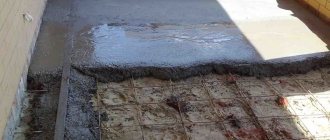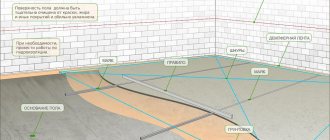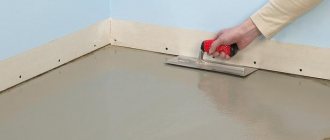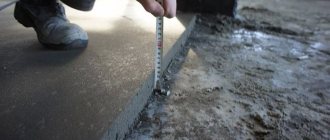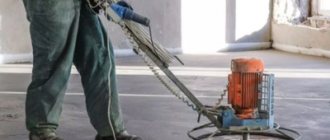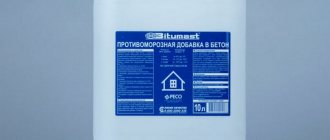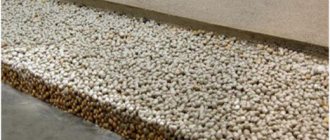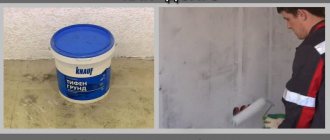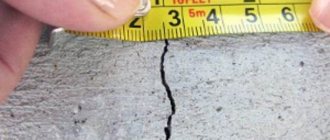Due to the considerable time allocated for preparatory work when repairing floors, the question “How long does it take for a concrete floor screed to dry?” very important. And you need to find out the answer to it not during the repair process, but before it. In this case, you can think through the progress of repair work during the setting and hardening of concrete and eliminate downtime. But most importantly, this will allow you to avoid defects in the construction of the floor and not spoil expensive finishing materials.
Concrete floor screed diagram.
Why is it important to dry the solution layer completely?
During renovations, many residents have to move out of their apartment and this brings considerable discomfort. I want to do the repairs not only efficiently, but also quickly, so that I can return home sooner. However, it is important to understand when the process can be accelerated and when it is not practical.
Concrete bases take the longest to dry; wet screeds take up to 25 days to dry. It is very important to allow the floor to dry completely, as a non-dry surface can cause:
- deformation;
- formation of cracks;
- shrinkage
Poor floor drying will negatively affect the floor covering and can lead to rotting and damage to parquet and laminate flooring. If you lay the tile on a dry screed, it will not be securely fixed, because the remaining moisture will affect the quality of the adhesive.
The durability and quality of the final floor covering depends on the drying of the screed.
Why you can’t artificially speed up drying
An important condition for high-quality drying is that the base mixture dries independently, without any artificial factors accelerating this process. This is due to the fact that the drying of a concrete or cement screed does not occur due to the evaporation of water from the solution, but due to the full stage of surface adhesion. Unfortunately, this takes a lot of time, but the results are worth it.
To ensure that the surface dries well, the surface of the screed is moistened with water during the first days. Self-made drafts and elevated temperatures can cause cracking of the base. Proceeding with subsequent work is strictly prohibited until the base coating has completely dried.
Solidification stages
Hardening includes two stages.
Solidification stage (for example, foundation)
Hardening period for several grades of concrete:
- Hardening time M 200 = two to two and a half hours.
- Hardening time M 300 = one and a half to two hours.
- Hardening time M 400 = one to two hours.
Kawabanga!
Description and principle of operation of a mobile concrete plant Return to contents
Solidification stage
The period for complete hardening of some grades of concrete:
- M 200 = fourteen to eighteen days.
- M 400 = seven to fourteen days.
What conditions need to be provided?
Many people who carry out home renovations on their own are concerned with the question: “What is needed to screed the floor in an apartment?” The materials have been purchased, the screed has been poured, and what needs to be done next to ensure reliable and complete hardening of the base. At this stage, it is very important to create the right conditions in the room.
If you speed up the drying process yourself, problems with deformation and cracks may appear in the future.
Factors influencing the desired indoor microclimate:
- absence of drafts;
- lack of access to direct sunlight for the first 7-10 days;
- no sudden temperature changes;
- preventing freezing of the screed.
The drying process slows down at elevated room temperatures and also at high humidity. The room temperature should be 22-24 °C, and the humidity should be between 60-70%. If the air humidity is below 50%, cover the floor with plastic film for the first 7-10 days.
Strength gain
The structural strength of a floor or any other structure and the time it takes for the cement mortar to harden are directly related. If the water leaves the concrete faster than necessary for setting and the cement does not have time to react, then after a certain period after drying we will encounter loose segments, leading to cracks and deformation of the screed.
These defects can be observed when cutting concrete products with a grinder, when the heterogeneous structure of the slab indicates a violation of the technological process.
According to technological rules, the concrete foundation dries for at least 25 - 28 days. However, for structures that do not perform increased load-bearing functions, this period is allowed to be reduced to five days, after which they can be walked on without fear.
How long does it take for a layer of gypsum mortar to dry?
The advantage of gypsum floor screed is the high speed of complete drying. The gypsum surface sets within 3-4 hours after installation, and complete drying takes place within a week. However, it is worth understanding that a week is an average value that is suitable for a base with a standard thickness of 4 cm.
The number of hours for a specific gypsum screed to dry is calculated by the worker independently. Thus, a 4 cm plaster coating dries in 168 hours. For each next centimeter of solution, another 90 hours are added.
An example of calculating the complete drying of a 7 cm thick gypsum screed:
168 hours + (3 cm X 90 hours) = 168 hours + 270 hours = 438 hours.
438 hours / 24 hours = 18, 25 days = 19 days.
Complete evaporation of moisture in a 7 cm thick gypsum screed will occur 19 days after pouring.
Complete drying of a 4 cm thick gypsum screed occurs 168 hours after pouring.
Video description
From the video you can learn about the reasons for a poorly executed screed and how to avoid it:
Under warm floor
Taking into account the minimum thickness for a full screed, the need to hide and protect the heating system, the leveling layer here is on average 6-7 cm. In this case, a liquid water-containing solution of cement, sand and small crushed stone is often used. This coating may take 10 weeks to dry.
Screed for underfloor heating Source buildup.ru
To reduce the time, you can add special hardeners and plasticizers to the working mass to reduce the layer. Experts also recommend considering gypsum-based compositions for the residential sector with light load on floors. And if you resort to the semi-dry method, then subsequent finishing can be carried out within 2-3 weeks.
How to speed up the drying process of a floor screed?
If the master is interested in a high-quality and durable floor base, it is not worth accelerating the evaporation of moisture from the surface. Create the necessary microclimate conditions for the room, which have already been mentioned. The room temperature must be at least 5°C. This is the minimum temperature that ensures the desired setting of the subfloor without losing its quality.
To ensure that the surface dries evenly and gradually, it can be covered with plastic wrap for the first week. In the second and third weeks, the base can be covered with sawdust; this will prevent moisture from evaporating intensively and will make drying more efficient and uniform.
How long does it take for cement screed to dry?
It is important to understand how long a cement floor should dry, since it is often poured during home renovations. Compared to a gypsum base, a floor surface made of a cement-sand mixture takes much longer to dry.
Factors influencing the drying of cement screed:
- thickness of the floor base;
- the presence of quick-drying fillers in the screed;
- quality of the waterproofing base.
It takes 28 days for 4 cm of cement screed to completely dry.
Inexperienced professionals may think that after a week the cement mixture is completely dry and ready for laying the topcoat, but there is still a lot of water left in the pores of the cement layer. Waterproofing material allows water to escape only through the surface of the base, and if laminate or parquet is laid in advance, this will lead to deformation of the coating.
A cement surface 1 cm thick requires 7 days to dry completely. So, 4 cm of cement-sand screed will dry in only 28 days. For every additional centimeter of such screed, 12-14 days are added.
What affects the drying speed of the screed
The time it takes for the screed to dry on the floor is often not satisfactory for the residents of the premises. To speed up drying, they came up with special quick-drying screeds that contain additional thinners, resins and polymer additives. They are added in advance to the main components or before the floor is poured. Their setting time is faster and this allows you to move on the poured base ahead of schedule. But it should be borne in mind that their complete drying will also take a long time. Information about complete drying of the quick-drying screed is on the packaging.
There are a large number of quick-drying mixtures, but they also require complete drying.
What does a violation of exposure time lead to?
Builders are advised to fully maintain the drying time of the mortar. If you put stress on it ahead of schedule, this can lead to a number of problems in the future:
- The appearance of cracks
- this is especially true for the foundations of buildings, which can be subject to fracture along the entire height. Often cracks appear not only in the foundation, but also in the ceilings or walls, and they are often through. To avoid troubles with the foundation, it is important to know how long concrete hardens in the ground. As a rule, the formwork is removed no less than 2 weeks after it is poured, otherwise the structure may be damaged. - Deformation
– common problems associated with insufficient concrete curing time include deformation processes in the foundation, cracking of the floor screed, and the formation of chips or dents on the walls. - Damage to finishing
- occurs after interior or exterior finishing work. For example, if a house was built from unseasoned aerated concrete, then plaster may fall off the walls or wallpaper may peel off. If the floor screed in the bathroom does not have enough time to harden, ceramic tiles may subsequently peel off from it.
Adding expanded clay and other dry mixes
To fill the floor, expanded clay granules or expanded clay crushed stone are often used, which allows you to produce a semi-dry screed with expanded clay. It hardens faster because it does not require the use of a large amount of water, insulates the floor and does not cause mold.
In addition to expanded clay, you can use:
- fiberglass;
- expanded polystyrene particles.
The use of fiber fiber is a new modern technology that has not yet earned mass trust and popularity. Hardening of the cement screed using the semi-dry method occurs after 12 hours, but complete hardening is no different from the classic wet poured screed.
Tiles can be laid on a semi-dry base 5-7 days after pouring.
Application of plasticizer
A special additive that enhances the strength of cement stone is a plasticizer. It increases the fluidity and plasticity of the mixture, which helps reduce the consumption of liquid and solution.
Using a plasticizer when pouring the screed reduces the drying time of the base by two days. Pay attention to the information on the packaging, as there are several types of plasticizers that perform different functions. Some reduce the hardening time, others increase the plasticity of the solution or its frost resistance.
The effect of waterproofing on drying speed
Particular attention should be paid to waterproofing the rough foundation, since improperly performed work will lead to increased drying of the floor screed. It is better to carry out waterproofing with roll materials in several layers in a checkerboard pattern. This will protect the future base of the floor from moisture. It is necessary to take into account that the waterproofing should also cover the walls of the room by 15-20 cm.
Particular attention is paid to the premises located on the ground floor. Dampness from the ground will have a strong impact on poor-quality waterproofing and can lead to deformation of the floor screed.
Before pouring the base of the floor, it is necessary to carry out high-quality waterproofing using bitumen mastic and roll materials
Budget option: installing an earthen floor in the garage
The most economical solution for a garage space is an earthen floor. It is quite easy and quick to make, and it requires virtually no financial investment. True, its technical characteristics and performance qualities are also not so high. The floor will not be very durable. In addition, unfortunately, earthen floors strongly absorb moisture.
However, there is a significant advantage: this flooring is ideal for those who do not use the garage very often.
Algorithm for arranging an earthen floor in a garage
Let's focus on simple instructions.
- First of all, it is necessary to mark the area for the foundation. The plant layer is completely removed.
- The base is flooded. The entire internal space is cleared and then leveled.
- After this, the base must be well compacted. You can use special equipment for tamping.
- The roof is being installed in the garage. After this, you can pour a layer of clay on the floor. The thickness should be approximately 10 cm, no less. In this case, it is advisable to use fatty clay.
- The base is carefully compacted again. It is better to use a heavy hand roller. Try to make the surface even and smooth.
Of course, some can do quite well without clay. It is not always possible to get good clay. But still, it is with it that the floor will become much stronger and a fairly high level of protection from moisture will be provided. Experienced garage workers note: if you take care of a good layer of clay, the floor in the garage will then become strong and relatively durable.
How to control the end of drying
In the construction industry, special instruments have been created to measure the complete drying of the floor screed. Such electronic moisture meters are expensive, and there is no point in buying them for home repairs.
At home, you can check whether the screed has dried completely using a napkin. It is placed on the surface of the base, covered with plastic film, which is fixed on all sides and left for a day. If after such a check the napkin remains dry, you can proceed to the finishing coating of the floor.
Dependence of strength gain time on concrete grade
The intensity of strength gain also depends on the grade of concrete. The lower the grade of concrete, the higher the strength characteristics will be. Compositions under the M15-M150 brands are characterized by a critical strength of up to 50%.
Structures made from M200-300 grade materials have a value of 40% of the grade. At the same time, the safe indicator allowed by standards is 50%, and construction work can begin only after receiving marks of 72% of the specified values.
To assess the strength properties of a concrete mixture, you can use two methods:
- Destructive. Involves crushing a cube using a press.
- Non-destructive. In this case, the properties of the material are determined without destructive effects.
The second technology is more in demand and is based on the use of elastic rebound devices, ultrasonic equipment or impact devices.
Recommendations
To increase the strength and durability of concrete and cement-sand screeds, rods or a mesh of reinforcing elements are used.
Reinforced screed will effectively improve the quality of the screed:
- it will prevent the formation of cracks during the drying process and during further use;
- reinforcement can withstand compression and tension loads;
- reinforcement prevents the base of the floor from subsidence.
The screed of a water heated floor must have a thickness of at least 40 mm. If the thickness of the base is less, this may affect the uniformity of heat distribution throughout the floor. For best heating, heat pipes should be laid in a snail shape. For high-quality fastening of elements, it is necessary to reinforce the screed using a mesh.
Tips for pouring a foundation
When choosing different types of foundation (tape, column, screw, slab), the requirements for the concrete mixture, the rules for pouring it, and condition monitoring technologies are the same. The curing times vary. At an average temperature of + 10 degrees Celsius you will need:
- For monolithic structures and vertical reinforced elements – 5 days.
- For horizontal structures – 14 days.
- For staircase structures with a length of 6 meters or more – 28 days.
During design, time intervals are established for the material to harden and achieve the required structural strength. For a construction worker, it is important to comply with established deadlines and conduct an examination before starting the next cycle of work.
When working in the cold season, the hardening time of concrete in the formwork increases by 2–3 times. In addition, builders will be required to strictly adhere to many rules and technologies to achieve the required result.
The reliability, strength and wear resistance of a structure directly depends on adherence to technology and the choice of building materials. To maintain performance characteristics for a long time, special attention will be required to respect the curing time of the concrete mixture.
